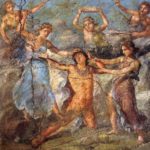τὰ δὲ λεγόμενα ἐς τὰ ξόανα καὶ ἐγὼ γράφω. Πενθέα ὑβρίζοντα ἐς Διόνυσον καὶ ἄλλα τολμᾶν λέγουσι καὶ τέλος ἐς τὸν Κιθαιρῶνα ἐλθεῖν ἐπὶ κατασκοπῇ τῶν γυναικῶν, ἀναβάντα δὲ ἐς δένδρον θεάσασθαι τὰ ποιούμενα: τὰς δέ, ὡς ἐφώρασαν, καθελκύσαι τε αὐτίκα Πενθέα καὶ ζῶντος ἄλλο ἄλλην τοῦ σώματος. ὕστερον δέ, ὡς Κορίνθιοι λέγουσιν, ἡ Πυθία χρᾷ σφισιν ἀνευρόντας τὸ δένδρον ἐκεῖνο ἴσα τῷ θεῷ σέβειν: καὶ ἀπ᾽ αὐτοῦ διὰ τόδε τὰς εἰκόνας πεποίηνται ταύτας.
Pausanias. Pausaniae Graeciae Descriptio, 3 vols. Leipzig, Teubner. 1903.
The Annenberg CPB/Project provided support for entering this text.
Why does the Pythia ask the Corinthians to worship the tree from which Pentheus spied on the women of Thebes?
In addition to the cases of faces painted red mentioned by Pausanias, the Romans painted the face of Jupiter Optimus Maximus on the Capitoline Hill red on festival days, and Pliny mentions that in Ethiopia the chiefs and statues of the gods were painted red (NH 33.111, 35.157). In Florence, the statue of St. Zenobius’ face is painted red. What is the significance of painting statues with red paint: a substitute for blood, ornamental, or some other reason?
